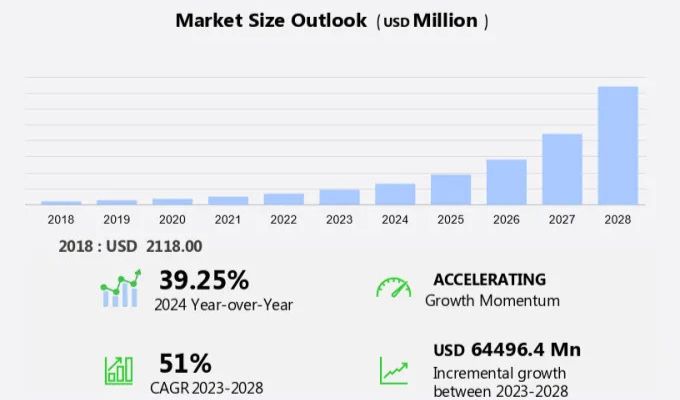In the fast-paced digital era, virtual assistants have become an integral part of our daily lives. From Siri to Google Assistant, these helpful AI companions have revolutionized the way we interact with technology. But what does the future hold for virtual assistants? In this article, we will delve into the impact and statistics for 2024, shedding light on the exciting advancements and possibilities that lie ahead.
According to recent research, the virtual assistant market is projected to reach a whopping $19.6 billion by 2025, growing at a CAGR of 34.0%. This exponential growth can be attributed to the increasing demand for automation and smart devices in both personal and professional spheres.

Moreover, with the advent of natural language processing (NLP), virtual assistants are becoming more sophisticated and capable of understanding complex human commands. From managing our schedules to ordering groceries, these AI-powered assistants are seamlessly integrating into our daily routines.
As the technology continues to mature, virtual assistants are expected to adopt a more personalized approach, tailoring their responses and suggestions to suit individual preferences. From healthcare to customer service, the potential applications of virtual assistants are limitless, promising a future where AI-powered companions become an indispensable part of our lives.
Get ready to explore the exciting world of virtual assistants and discover how they are transforming the way we live, work, and interact with technology.
Evolution of Virtual Assistants
The concept of virtual assistants can be traced back to the early days of computing, where researchers and developers envisioned a future where machines could understand and respond to human commands. The first significant milestone in this journey was the creation of ELIZA, an early natural language processing computer program developed at the MIT Artificial Intelligence Laboratory in the 1960s. ELIZA was designed to mimic a psychotherapist, engaging in conversation and providing responses based on the user’s input.
As technology continued to evolve, virtual assistants became more sophisticated and capable of handling a wider range of tasks. The 1990s saw the emergence of digital personal assistants, such as Microsoft’s Clippy, which aimed to provide users with helpful suggestions and guidance within productivity software. While these early virtual assistants were often criticized for their limited functionality and intrusive nature, they paved the way for the more advanced and user-friendly virtual assistants we know today.
The turning point in the evolution of virtual assistants came with the introduction of voice-activated assistants, such as Apple’s Siri, Google Assistant, and Amazon’s Alexa. These AI-powered companions leveraged advancements in natural language processing, speech recognition, and machine learning to understand and respond to human speech in a more natural and intuitive manner. The widespread adoption of smartphones and smart home devices further fueled the growth of virtual assistants, making them an integral part of our daily lives.
Benefits of Using Virtual Assistants
One of the primary benefits of using virtual assistants is the increased efficiency and productivity they bring to our lives. These AI-powered companions can handle a wide range of tasks, from scheduling appointments and setting reminders to conducting web searches and controlling smart home devices. By automating these mundane yet necessary tasks, virtual assistants free up our time and mental energy, allowing us to focus on more important and meaningful activities.
Moreover, virtual assistants are available 24/7, providing users with on-demand assistance whenever they need it. Whether it’s checking the weather, setting a timer, or obtaining directions, these AI-powered helpers are always ready to lend a hand, making our lives more convenient and streamlined.
Another significant benefit of virtual assistants is their ability to learn and adapt to individual user preferences and habits. As we interact with these AI companions, they gather data and insights that allow them to personalize their responses and suggestions, providing a more tailored and personalized experience. This level of customization not only enhances user satisfaction but also helps virtual assistants become more integrated into our daily routines.
Virtual Assistants in Different Industries
The versatility of virtual assistants has led to their widespread adoption across various industries, each with its unique set of applications and use cases.
In the healthcare sector, virtual assistants are being leveraged to improve patient outcomes and streamline administrative tasks. These AI-powered companions can assist patients with scheduling appointments, managing medication reminders, and providing general health information. Additionally, virtual assistants are being integrated into telemedicine platforms, allowing healthcare providers to offer more personalized and accessible care.

The retail and e-commerce industry has also embraced virtual assistants, using them to enhance the customer experience. Virtual assistants can help customers with product searches, provide personalized recommendations, and even facilitate the checkout process. By offering this level of support and guidance, retailers can improve customer satisfaction and loyalty, ultimately driving sales and revenue.
In the financial services industry, virtual assistants are being utilized to streamline operations and provide personalized financial advice. These AI-powered companions can assist customers with tasks such as checking account balances, making payments, and even offering investment guidance based on individual financial goals and risk profiles. This integration of virtual assistants into the financial sector can help improve customer engagement and reduce the workload on human financial advisors.
Virtual Assistants and Artificial Intelligence
The rapid advancements in artificial intelligence (AI) have played a pivotal role in the evolution of virtual assistants. AI technologies, such as natural language processing (NLP), machine learning, and deep learning, have enabled virtual assistants to understand and respond to human language in a more natural and contextual manner.
NLP, in particular, has been a game-changer for virtual assistants, allowing them to comprehend the nuances and complexities of human speech. By analyzing the semantic and syntactic structure of language, NLP algorithms can interpret the user’s intent and provide relevant and meaningful responses. This has led to a more seamless and intuitive interaction between humans and their virtual assistants.
Machine learning, on the other hand, has empowered virtual assistants to learn and adapt over time. As users interact with their AI companions, the virtual assistants can gather data and insights, which are then used to refine their algorithms and improve their performance. This self-learning capability enables virtual assistants to become more personalized and attuned to the individual user’s preferences and habits.
Furthermore, the integration of deep learning techniques has enabled virtual assistants to handle more complex tasks, such as image recognition, language translation, and even task planning. By leveraging the power of deep neural networks, virtual assistants can process and analyze vast amounts of data, unlocking new possibilities for intelligent automation and decision-making.
Virtual Assistants and Voice Recognition Technology
The rise of virtual assistants has been closely intertwined with the advancements in voice recognition technology. The ability to convert human speech into machine-readable commands has been a crucial enabler for the widespread adoption of virtual assistants.
Voice recognition technology relies on a combination of speech recognition algorithms and natural language processing to interpret and respond to user commands. By analyzing the acoustic features of speech, these algorithms can accurately identify the words and phrases spoken by the user, allowing virtual assistants to understand and execute the desired tasks.
One of the key advantages of voice-based interactions is the increased accessibility and convenience they offer. Users can simply speak their requests or questions, without the need to type or navigate through menus, making the interaction more natural and intuitive. This has been particularly beneficial for individuals with disabilities or those who prefer hands-free interactions, further expanding the reach and impact of virtual assistants.
Moreover, the continuous advancements in voice recognition technology have led to improved accuracy, reduced latency, and enhanced language support. Virtual assistants can now understand a wider range of accents, dialects, and languages, making them more inclusive and accessible to a global user base.
As voice recognition technology continues to evolve, it is expected to play an even more integral role in the future of virtual assistants. Integrating advanced features, such as speaker identification, emotion recognition, and multilingual support, will further enhance the user experience and unlock new possibilities for intelligent automation.
Virtual Assistants and Data Privacy Concerns
While the benefits of virtual assistants are undeniable, the increasing integration of these AI-powered companions into our daily lives has also raised concerns about data privacy and security.
Virtual assistants, by their very nature, require access to a significant amount of personal data, including our voice recordings, search histories, and even location information. This data is often collected and analyzed by the technology companies behind these virtual assistants, raising questions about how this information is being used and stored.
Concerns have been raised about the potential for data breaches, where malicious actors could gain unauthorized access to the sensitive information gathered by virtual assistants. Additionally, there are worries about the potential for these AI-powered companions to be used for surveillance or targeted advertising, compromising individual privacy and autonomy.
To address these concerns, technology companies and policymakers have been working to implement robust data privacy and security measures. This includes the adoption of encryption protocols, the implementation of user consent mechanisms, and the development of transparent data management policies.
Furthermore, there is an increasing emphasis on empowering users to have more control over their data, with virtual assistant platforms offering options for data deletion, opt-out features, and granular privacy settings. As the virtual assistant market continues to grow, it is crucial that these privacy and security considerations remain a top priority, ensuring that the benefits of these AI-powered companions are not overshadowed by the risks to individual privacy.
Statistics on the Growth of Virtual Assistants
The rise of virtual assistants has been nothing short of remarkable, with the market experiencing exponential growth in recent years. According to a report by MarketsandMarkets, the global virtual assistant market is expected to grow from $3.9 billion in 2020 to $19.6 billion by 2025, at a CAGR of 38.1% during the forecast period.
This rapid growth can be attributed to several factors, including the increasing adoption of smart home devices, the growing demand for personalized digital experiences, and the widespread availability of voice-enabled technologies.

In terms of user adoption, a study by Voicebot.ai reveals that the number of U.S. adults using virtual assistants has grown from 66.4 million in 2018 to 89.5 million in 2021, representing a 35% increase. Furthermore, the study found that the usage of virtual assistants on smartphones has remained consistently high, with 85.8% of U.S. adults using them in 2021.
The integration of virtual assistants into various industries has also contributed to their growth. A report by MarketsandMarkets highlights that the healthcare sector is expected to be the fastest-growing segment for virtual assistants, with a CAGR of 40.8% from 2020 to 2025. This can be attributed to the increasing demand for personalized healthcare solutions and the need for streamlined administrative processes.
Moreover, the rise of smart home devices, such as Amazon Echo and Google Home, has driven the adoption of virtual assistants in the consumer electronics market. According to a report by Statista, the global smart speaker market is expected to reach $35.5 billion by 2025, with virtual assistants playing a central role in this growth.
As the technology continues to mature and new use cases emerge, the future of virtual assistants looks exceptionally promising, with the potential to transform the way we interact with technology and each other.
Predictions for the Future of Virtual Assistants in 2024
As we look ahead to the year 2024, the future of virtual assistants promises to be both exciting and transformative. With the continued advancements in artificial intelligence, natural language processing, and voice recognition technology, these AI-powered companions are poised to become even more integrated into our daily lives.
One of the key predictions for 2024 is the increased personalization and contextual awareness of virtual assistants. By leveraging machine learning algorithms and data analytics, these AI companions will be able to better understand individual user preferences, habits, and needs. This will enable them to provide more tailored recommendations, anticipate user requests, and offer personalized solutions, further enhancing the user experience.
Furthermore, virtual assistants are expected to become more proactive and autonomous in their actions. Instead of simply responding to user commands, they will be able to initiate tasks, make suggestions, and even engage in more natural and conversational interactions. This level of proactivity will allow virtual assistants to become true partners in productivity, helping users manage their schedules, prioritize tasks, and make informed decisions.
Another anticipated development in the future of virtual assistants is the integration of multimodal interactions. In addition to voice-based commands, virtual assistants will be able to understand and respond to various input modalities, such as text, gestures, and even facial expressions. This will enable a more seamless and intuitive user experience, allowing individuals to interact with their AI companions in the most natural and convenient way possible.
As virtual assistants continue to evolve, their applications are expected to expand beyond the personal realm and into the professional and enterprise domains. Virtual assistants will become increasingly adept at handling complex tasks, such as customer service, project management, and data analysis, freeing up human workers to focus on more strategic and creative endeavors.
Moreover, the integration of virtual assistants with emerging technologies, such as augmented reality and the Internet of Things, will unlock new possibilities for intelligent automation and contextual assistance. Imagine a future where your virtual assistant can guide you through a complex repair task, using augmented reality overlays to provide step-by-step instructions, or where your smart home devices seamlessly communicate with your virtual assistant to optimize energy usage and comfort levels.
As we approach 2024, the future of virtual assistants is brimming with possibilities. These AI-powered companions will continue to evolve, becoming more intelligent, personalized, and indispensable in our daily lives. By embracing the potential of virtual assistants, we can unlock new levels of productivity, convenience, and innovation, shaping a future where technology and human collaboration truly thrive.
Conclusion
The future of virtual assistants is undoubtedly bright, with the potential to transform the way we interact with technology and each other. From increased personalization and proactivity to the integration of multimodal interactions and enterprise-level applications, the advancements in virtual assistants are poised to revolutionize our daily lives.
As we look ahead to 2024, the virtual assistant market is expected to experience exponential growth, driven by the increasing adoption of smart devices, the demand for personalized digital experiences, and the continuous advancements in artificial intelligence and voice recognition technology.
However, with the growing integration of virtual assistants into our lives, it is crucial that we address the concerns surrounding data privacy and security. Technology companies and policymakers must work together to implement robust measures that protect user data and ensure the responsible use of these AI-powered companions. By embracing the potential of virtual assistants and addressing the associated challenges, we can unlock a future where technology and human collaboration thrive. These AI-powered companions will become indispensable partners, enhancing our productivity, convenience, and overall quality of life. As we continue to explore the exciting world of virtual assistants, the possibilities for innovation and transformation are truly limitless.